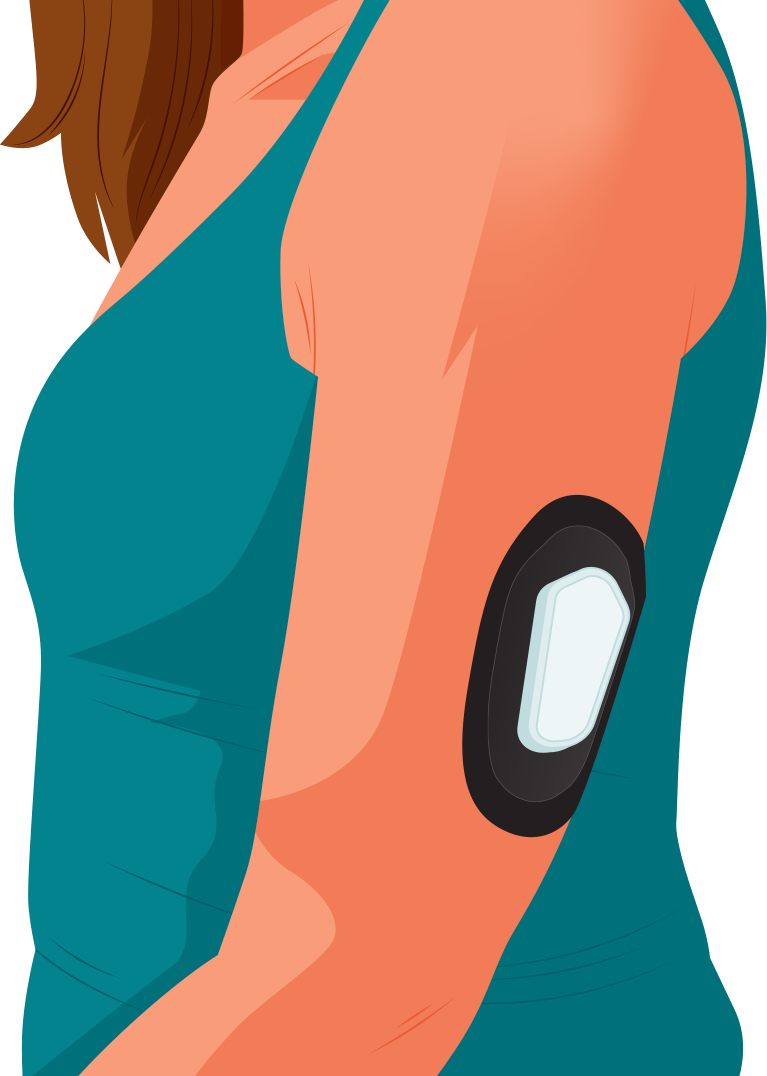


Monitor your blood glucose levels
Eating (and planning!) consistent, balanced meals is a keystone habit for regulating your blood glucose levels
and preventing spikes.
Eat a balanced diet
If you’re not used to exercising much, that’s OK.
You can slowly build movement into your routine over time. For your kickoff week, you could start by walking a little bit each day — after dinner, for example. Then, build on that week after week by adding more walking time or other activities. Focusing on incorporating movement you enjoy can help you stay motivated and benefit your overall well-being.
Get sweaty
Research has shown that drinking less water, even just
for a few days, can impair blood glucose management
in people with type 2 diabetes.
Add a few hydration tactics into your daily and weekly routine to help keep blood glucose in a healthy range.
Top up your water bottle
Sleep well
The people in your life play a bigger role than you might think in helping you manage your blood glucose.
You can get (and give!) moral support, real-life tips, and motivation to stay on track.
Stay connected
17 Tips for Smarter
Weekly Glucose Management
est. read time: 7 min

Meal prep


People often build their meals around meat or protein, treating fruits and vegetables as a sideshow. The plate method is an easy way to remember healthy proportions: fill half your plate with non-starchy fruits and vegetables, a quarter with meat or other protein, and the final quarter with whole grains and other fiber-packed carbs.
Make fruits and vegetables
the main event





If you’re pregnant or have a health condition other than diabetes, your recommended range may be different. Ask your doctor what blood glucose range you should aim for.
Check whether your current
blood glucose values fall within your healthy range


Keep your doctor up to date


Practice self-compassion when
you don’t meet your goals


Bake exercise into your routine


See how much of an impact moving your body has on your blood glucose levels. It’ll help you fine-tune your routine for better blood glucose management.
Check your blood glucose
before and after exercise





One of the easiest ways to monitor whether you’re getting enough water throughout the day is to check your pee color.
When your pee is light yellow, about the color of lemonade, your hydration is optimal. If your pee is much darker than that, it’s a sign you need to drink more.
Check your pee color


Stock up on herbal tea
or sparkling water




Going to bed and waking up at the same time every day has also been shown to improve sleep.
Make sure you get enough


on the cooler side at night can help you fall asleep faster, too.
Take a warm shower
or bath before bed


Even dim light exposure in your bedroom can have a major impact on your sleep quality. Consider getting blackout curtains or blinds
and covering light-emitting electronics in your bedroom at night.
Block out light at night





Making a social commitment to others to meet
up and move your body is an excellent way to stay motivated. That might involve joining the local ping pong club or soccer team, trying out
a running, walking, or biking group, or going on hikes with a friend on a regular basis.
Try group exercise


It can help to speak with others who are going through many of the same things you are with type 2 diabetes (T2D) or prediabetes. It’s a great place to get moral support, answers to your questions, and helpful tips.
Ask your doctor or pharmacist to recommend
a local support group, and consider joining an online support community like Bezzy T2D.
Join a T2D support group




Getting longer, better quality Zzz’s can help manage
your blood glucose levels, alongside many other health benefits. Here’s how to settle in for a great sleep.
When should I check my blood glucose?
What do my blood glucose readings mean?
What can I do to improve my readings?
Having meals at the ready can help you make healthy eating decisions on the fly.
Consider batch-preparing a few healthy staples once a week to keep on hand in the fridge, freezer, and pantry. For example, pre-portioned containers of trail mix can help you make a healthy choice when you’re craving a snack.
The Centers for Disease Control and Prevention (CDC) recommends getting 150 minutes of
physical activity per week. If that sounds like a
lot, consider making exercise an essential part
of your lifestyle. Ride your bike to get to work
or walk your dogs daily.
If you miss a workout or don’t do as well as you had hoped, it can be tempting to beat yourself
up and try to work double hard to make up for it. But hey — it happens to us all, and it’s OK.
Practice forgiving yourself, moving on, and doing what you can. Tomorrow is a new day!






Monitoring your blood glucose levels throughout the
day can help you understand what causes it to spike or
dip below typical levels.
When you know how your body reacts to certain foods, activities, medications, and other factors, you can make
better decisions throughout your day.



Keep your fridge and pantry well-stocked with blood-glucose-friendly staples you enjoy.
Carb-based foods that absorb more slowly into your bloodstream are low glycemic index foods. Try adding some new-to-you low glycemic index foods to your grocery list this week.
Shop for your favorite
low-glycemic load foods


Eating fiber with your sources of carbs helps
your body absorb them more slowly into your bloodstream, which helps keep your blood glucose steady.
Examples of carb-fiber combos include lentil curry with rice, noodle soup packed with
veggies, or a generous dollop of hummus
on bread or crackers.
Combine your carbs with fiber


Many whole foods are packed with water,
so when you snack on them, you’re helping
your body stay hydrated—and giving it lots
of nutrients, too. Win-win!
Cantaloupe, strawberries, watermelon, apples, pears, cooked squash, grapes, and oranges
are just a few examples of foods with high
water content. Add your favorites to your
weekly grocery list to make sure you’re eating them regularly.
Eat your water


The more your doctor knows about your current blood glucose readings and what triggers spikes, the better they can help you manage them. Gain insights by asking questions, too.
Here are a few basic questions to bring to your next appointment, along with a record of your blood glucose readings:
Aim to keep your blood glucose levels between:
80 to 130 mg/dL before you eat a meal
below 180 mg/dL after you’ve eaten
(test about 1-2 hours later)






































































You don’t necessarily need your water bottle with you at all times to stay hydrated. Sipping
on herbal tea throughout the day is a soothing way to get enough H2O.
Try combining water with pureed fruit to make agua fresca for healthy hydration. Consider making a batch once or twice a week to keep
in the fridge.
Your body temperature naturally lowers at night, and heating your body with a warm shower or bath has been shown to help your body cool itself down afterward. For best results, bathe
1 to 2 hours before bed. Keeping your bedroom
Sleep shouldn’t be an afterthought. Regularly getting the amount you need helps your health
in many ways. Adults of all ages need at least 7 hours of sleep a night, according to the CDC.